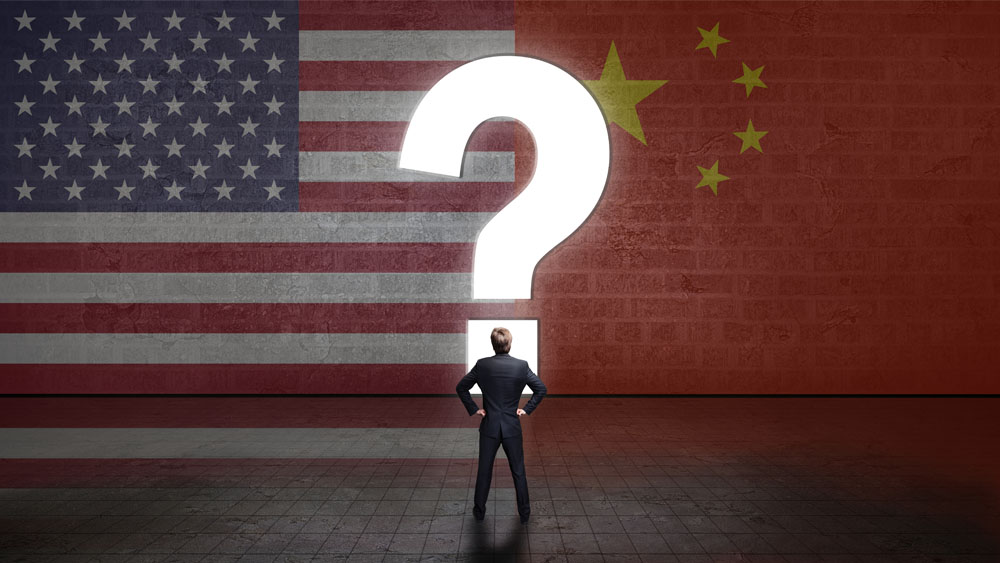US – China Relations: From COVID-19 Tensions to Diplomatic Boycotts

The United States and China have one of the world’s most significant and intricate bilateral relationships, characterized by periods of tension and cooperation on issues such as trade, climate change, and Taiwan.
October 1949: People’s Republic of China Established
On October 1, 1949, Mao Zedong established the People’s Republic of China in Beijing after the Communist Party defeated the Nationalist government of Chiang Kai-shek, who then fled to Taiwan. The U.S., having supported the Nationalists during World War II, backed Chiang’s exiled government, leading to limited U.S. relations with mainland China for decades.
June 1950: Korean War Breaks Out
The Korean War began on June 25, 1950, when North Korea, backed by the Soviet Union, invaded South Korea. The U.S. and the United Nations rushed to defend South Korea. China entered the war in support of North Korea when UN and South Korean troops approached its border. The conflict resulted in millions of deaths before an armistice was signed in 1953.
August 1954: First Taiwan Strait Crisis
In 1953, President Dwight Eisenhower lifted the U.S. Navy blockade of Taiwan, prompting Chiang Kai-shek to deploy troops to islands in the Taiwan Strait. China’s People’s Liberation Army responded by shelling the islands. The U.S. signed a mutual defense treaty with Taiwan and threatened nuclear action against China, leading to negotiations in 1955. Further crises occurred in 1956 and 1996.
March 1959: Tibetan Uprising
A major uprising against Chinese control erupted in Tibet in 1959, resulting in thousands of deaths and the Dalai Lama fleeing to India. The U.S. condemned China’s human rights abuses and the CIA supported the Tibetan resistance.
October 1964: China’s First Atomic Test
China conducted its first atomic bomb test in October 1964, amidst escalating U.S.-Sino tensions over Vietnam. By then, China had amassed troops along its Vietnam border.
March 1969: Sino-Soviet Border Conflict
Tensions between China and the Soviet Union culminated in border skirmishes in 1969. The Sino-Soviet split shifted China’s threat perception from the U.S. to the Soviet Union, paving the way for improved U.S.-China relations.
April 1971: Ping-Pong Diplomacy
Relations began to thaw in 1971 when China invited the U.S. ping-pong team, leading to Secretary of State Henry Kissinger’s secret trip to China. Later that year, the United Nations recognized the People’s Republic of China, granting it a permanent Security Council seat.
February 1972: Nixon Visits China
President Richard Nixon visited China in February 1972, meeting Mao Zedong and signing the Shanghai Communiqué, which allowed for discussions on difficult issues, including Taiwan, marking a significant step towards improved relations.

1979: Formal Ties and One-China Policy
President Jimmy Carter formally recognized China in 1979, adhering to the One-China policy and severing official ties with Taiwan. Chinese Vice Premier Deng Xiaoping’s visit to the U.S. highlighted the budding relationship, although the Taiwan Relations Act maintained U.S. obligations to Taiwan’s defense.
July 1982: China in the Reagan Era
Under President Ronald Reagan, the U.S. issued the “Six Assurances” to Taiwan and signed a communiqué with China, reaffirming the One-China policy while also allowing Beijing to purchase U.S. military equipment, balancing relations between China and Taiwan.
June 1989: Tiananmen Square Massacre
The Tiananmen Square protests in 1989 led to a brutal crackdown by Chinese troops, resulting in hundreds of deaths. The U.S. responded by suspending military sales to China and freezing relations.
September 1993: Prominent Dissidents Deported
China released political prisoner Wei Jingsheng in 1993, coinciding with President Bill Clinton’s policy of “constructive engagement.” Despite renewed imprisonment after losing the bid to host the 2000 Olympics, Wei was eventually deported to the U.S.
March 1996: Taiwan’s First Free Presidential Vote
Lee Teng-hui’s victory in Taiwan’s first free presidential election in 1996, despite Chinese missile tests, marked a significant democratic milestone. The U.S. and China exchanged officials again, following a brief diplomatic freeze.
May 1999: Belgrade Embassy Bombing
NATO’s accidental bombing of the Chinese embassy in Belgrade in 1999 strained relations, leading to Chinese protests. The U.S. and NATO apologized for the incident, citing intelligence errors.

October 2000: Normalized Trade Relations
The U.S.-China Relations Act of 2000, signed by President Clinton, granted China permanent normal trade relations and paved the way for its entry into the World Trade Organization in 2001. U.S.-China trade grew substantially over the following decades.
April 2001: U.S.-Sino Spy Plane Standoff
A U.S. reconnaissance plane collided with a Chinese fighter in April 2001, leading to a tense standoff and the detention of the U.S. crew on Hainan Island. The crew was released after twelve days, following diplomatic negotiations.
September 2005: ‘Responsible Stakeholder ’In
In September 2005, U.S. Deputy Secretary of State Robert B. Zoellick initiated a strategic dialogue with China during a meeting with Chinese Foreign Minister Li Zhaoxing in Beijing. Zoellick called on China to become a “responsible stakeholder” and use its growing influence to integrate nations such as Sudan, North Korea, and Iran into the international system. Despite these efforts, North Korea withdrew from the Six-Party Talks aimed at curbing its nuclear ambitions. After North Korea’s first nuclear test in October 2006, China mediated to bring Pyongyang back to the negotiating table.
March 2007: China Increases Military Spending
China announced an 18 percent increase in its defense budget for 2007, bringing it to over $45 billion. This increase continued the trend of averaging 15 percent annual growth in military spending from 1990 to 2005. During a tour of Asia, U.S. Vice President Dick Cheney remarked that China’s military buildup contradicted its stated goal of a “peaceful rise.” China defended its spending, citing the need for better training, higher salaries for soldiers, and the protection of national security and territorial integrity.
September 2008: China Becomes Largest U.S. Foreign Creditor
In September 2008, China surpassed Japan to become the largest holder of U.S. debt, holding around $600 billion in treasuries. This highlighted the growing interdependence between the U.S. and Chinese economies, especially as the global financial crisis raised concerns about economic imbalances.
August 2010: China Becomes World’s Second-Largest Economy
China overtook Japan as the world’s second-largest economy in August 2010, with a valuation of $1.33 trillion for the second quarter, compared to Japan’s $1.28 trillion. China’s GDP for 2010 totaled $5.88 trillion, surpassing Japan’s $5.47 trillion, and projections indicated China could overtake the U.S. as the world’s largest economy by 2027.

November 2011: U.S. ‘Pivots’ Toward Asia
In an essay for Foreign Policy, U.S. Secretary of State Hillary Clinton outlined a strategic “pivot” to Asia, emphasizing increased diplomatic, economic, and strategic investments in the Asia-Pacific region. This move was perceived as an effort to counter China’s growing influence. During the Asia-Pacific Economic Cooperation summit, President Obama announced a new Trans-Pacific Partnership, which was later complemented by the deployment of 2,500 U.S. marines in Australia, drawing criticism from Beijing.
February 2012: Rising Trade Tensions
The U.S. trade deficit with China rose to $295.5 billion in 2011, accounting for three-quarters of the growth in the U.S. trade deficit that year. In March 2012, the U.S., EU, and Japan filed a request for consultations with China at the World Trade Organization over its restrictions on rare earth metal exports, arguing these quotas violated international trade norms. China defended its actions as fair and vowed to protect its trade rights.
April 2012: Dissident Flees to U.S. Embassy
Blind Chinese dissident Chen Guangcheng escaped house arrest in Shandong province and fled to the U.S. embassy in Beijing. U.S. diplomats negotiated his stay in China to study law, but Chen later requested to move to the United States, straining diplomatic ties. Ultimately, both nations agreed to allow Chen to study in the U.S. as a student rather than an asylum seeker, avoiding a diplomatic crisis.
November 2012: China’s New Leadership
The 18th National Party Congress marked significant leadership changes, with Xi Jinping replacing Hu Jintao as president, general secretary of the Communist Party, and chairman of the Central Military Commission. Premier Li Keqiang also assumed his role, and Xi began promoting the idea of China’s “rejuvenation.”
June 7–8, 2013: Sunnylands Summit
President Obama hosted President Xi Jinping at the Sunnylands Estate in California for a “shirt-sleeves summit” aimed at building personal rapport and easing U.S.-China tensions. They pledged to cooperate on global issues like climate change and North Korea and to establish a “new model” of U.S.-China relations, reflecting Xi’s vision of a “new type of great power relations.”
May 19, 2014: U.S. Indicts Chinese Nationals
The U.S. indicted five Chinese hackers with ties to the People’s Liberation Army for stealing trade secrets from U.S. companies. In response, China suspended its cooperation in the U.S.-China cybersecurity working group. Later, U.S. authorities suggested Chinese hackers were behind a major breach of the Office of Personnel Management.
November 12, 2014: Joint Climate Announcement
During the APEC summit in Beijing, President Obama and Xi issued a joint statement on climate change, pledging to reduce carbon emissions. Obama set ambitious targets for U.S. emissions cuts, while Xi made China’s first promise to curb emissions growth by 2030, boosting hopes for global climate negotiations.

May 30, 2015: U.S. Warns China Over South China Sea
At the Shangri-La Dialogue, U.S. Secretary of Defense Ashton Carter called on China to halt its land reclamation efforts in the South China Sea. U.S. officials provided evidence of China’s military equipment on artificial islands, despite Beijing’s claims that the constructions were primarily for civilian purposes.
February 9, 2017: Trump Affirms One-China Policy
President Trump affirmed the One-China policy in a call with President Xi Jinping, after initially questioning it by speaking with Taiwanese President Tsai Ing-wen. Secretary of State Rex Tillerson later described the U.S.-China relationship as one based on non-confrontation and mutual respect.
April 6–7, 2017: Trump Hosts Xi at Mar-a-Lago
President Trump hosted President Xi at the Mar-a-Lago estate, focusing on bilateral trade and North Korea. They reached a ten-part trade agreement to expand the trade of products like beef and poultry. However, contentious issues like tariffs on aluminum and steel remained unresolved.
2018 – 2020: Trade Tensions and Beyond
March 22, 2018: Trump Tariffs Target China
The Trump administration announced tariffs on Chinese imports worth at least $50 billion, targeting goods like clothing and electronics in response to alleged Chinese theft of U.S. technology. China imposed retaliatory tariffs, raising concerns about a trade war.
July 6, 2018: U.S.-China Trade War Escalates
The U.S. imposed additional tariffs on $34 billion worth of Chinese goods, prompting China to retaliate with tariffs on U.S. products. The escalating trade war saw both countries implementing further tariffs on each other’s goods.
October 4, 2018: Pence Speech Signals Hard-Line Approach
Vice President Mike Pence outlined a hard-line U.S. policy toward China, prioritizing competition over cooperation and criticizing China for economic aggression, military aggression, censorship, and intellectual property theft. China condemned the speech as groundless and warned of potential harm to U.S.-China relations.

December 1, 2018: Canada Arrests Huawei Executive
Meng Wanzhou, CFO of Huawei, was arrested in Canada at the U.S.’s request, leading to a legal battle and increased tensions between the U.S. and China. China detained two Canadian citizens in retaliation. Meng was released in 2021 after reaching a deal with U.S. prosecutors.
March 6, 2019: Huawei Sues the United States
Huawei sued the U.S. for banning federal agencies from using its equipment, amid concerns over potential Chinese government spying. The Trump administration’s campaign against Huawei aimed to prevent countries from using its equipment in 5G networks.
May 10, 2019: Trade War Intensifies
Following failed trade talks, the U.S. increased tariffs on $200 billion worth of Chinese goods. China retaliated with tariffs on $60 billion worth of American goods. The U.S. also banned companies from using foreign-made telecommunications equipment deemed a security threat, targeting Huawei.
August 5, 2019: U.S. Labels China a Currency Manipulator
The U.S. designated China as a currency manipulator after the yuan weakened significantly. This symbolic designation came shortly after the U.S. announced higher tariffs on Chinese goods, prompting Beijing to warn of potential financial market turmoil.
November 27, 2019: Trump Signs Bill Supporting Hong Kong Protesters
President Trump signed the Hong Kong Human Rights and Democracy Act, authorizing sanctions on individuals responsible for human rights abuses in Hong Kong. China condemned the move and imposed sanctions on U.S. organizations while suspending warship visits to Hong Kong.
January 15, 2020: ‘Phase One’ Trade Deal Signed
President Trump and Chinese Vice Premier Liu He signed the “Phase One” trade deal, easing the trade war. The deal relaxed some U.S. tariffs and committed China to buying $200 billion worth of American goods, though it left key issues unresolved, including Chinese subsidies.
January 31, 2020 Tensions Soar Amid COVID-19 Pandemic
A police officer guards an animal market in Wuhan, China, where a new coronavirus was reported in January. Hector Retamal/AFP/Getty Images
The Trump administration bars all non-U.S. citizens who recently visited mainland China from entering the United States amid an outbreak of a new coronavirus first reported in Wuhan, China. By March, the World Health Organization (WHO) designated the outbreak a pandemic, after it spread to more than one hundred countries. Leading officials in both China and the United States blame the other side for the pandemic. A Chinese Foreign Ministry spokesperson claims without evidence that the U.S. military brought the virus to China, while President Trump repeatedly refers to the virus as the “Chinese virus,” blaming its spread on the Chinese government’s failures. In April, top officials in both countries change their tone by highlighting areas for cooperation amid the crisis. Still, Trump accuses the WHO of being biased toward China and halts U.S. funding to the organization.

March 18, 2020, China Expels American Journalists
Wall Street Journal reporters pose for a photo before departing from Beijing Capital International Airport. Greg Baker/AFP/Getty Images
The Chinese government expels at least thirteen journalists from three U.S. newspapers—the New York Times, Wall Street Journal, and Washington Post—whose press credentials are set to expire in 2020. Beijing also demands that those outlets, as well as TIME and Voice of America, share information with the government about their operations in China. The Chinese Foreign Ministry says the moves are in response to the U.S. government’s decision earlier in the year to limit the number of Chinese journalists from five state-run media outlets in the United States to 100, down from 160, and designate those outlets as foreign missions. In November 2021, Washington and Beijing agreed to ease restrictions on journalists working in each other’s countries.
July 14, 2020, Trump Ends Hong Kong’s Special Status
Riot police detain a man after clearing a protest against the new national security law in Hong Kong. Dale De La Rey/AFP/Getty Images
Two weeks after Beijing passed a new national security law for Hong Kong, President Trump signed an executive order ending the city’s preferential trade status with the United States. He also signed legislation to sanction officials and businesses that undermine Hong Kong’s freedoms and autonomy. Chinese officials threaten to impose retaliatory sanctions on U.S. individuals and entities. They denounce what they call U.S. interference in China’s internal affairs, including Washington’s announcement a day earlier declaring most of Beijing’s claims in the South China Sea illegal.
July 22, 2020, U.S., China Close Consulates in Diplomatic Escalation
A worker removes a plaque from the U.S. consulate in Chengdu. Thomas Peter/Reuters
The United States ordered China to close its consulate in Houston, Texas, alleging that it was a hub of espionage and intellectual property theft. China condemns the order and retaliates by closing the U.S. consulate in Chengdu. In the same week, Washington indicts two Chinese hackers for allegedly stealing coronavirus vaccine research and sanctions eleven Chinese companies for their reported role in human rights abuses in Xinjiang. Meanwhile, Chinese Foreign Minister Wang Yi blames the United States for the tensions.
July 23, 2020, Pompeo Says Engagement With China Has Failed
Secretary of State Pompeo speaks at the Richard Nixon Presidential Library and Museum in California. Ashley Landis/Pool/Reuters
U.S. Secretary of State Mike Pompeo delivers a speech titled “Communist China and the Free World’s Future,” signaling a profound shift in U.S. policy. He declares that the era of engagement with the Chinese Communist Party is over, condemning its unfair trade practices, intellectual property theft, human rights abuses in Xinjiang and Hong Kong, and aggressive moves in the East and South China Seas. He calls on Chinese citizens and democracies worldwide to press Beijing to change its behavior and respect the rules-based international order.
November 2020 – December 2020 Trump Ramps Up Pressure as Transition Looms
President Trump attempts to cement his legacy of being tough on China during his final weeks in office. Director of National Intelligence John Ratcliffe calls China “the greatest threat to America today,” while the Commerce Department adds dozens of Chinese companies, including the country’s biggest chipmaker, Semiconductor Manufacturing International Corporation (SMIC), to its trade blacklist. The State Department tightens visa rules for around ninety million members of the Chinese Communist Party. It also sanctions more Chinese officials, including fourteen members of China’s legislative body, over abuses in Hong Kong, Xinjiang, and elsewhere. Additionally, the White House bans U.S. investments in Chinese companies it says have ties to the People’s Liberation Army. Chinese officials vow retaliation against these and other actions taken by the Trump administration.
January 21, 2021, U.S. Designates China’s Abuses of Uyghurs as Genocide
Protesters join a rally in Washington, DC, to encourage countries to label China’s treatment of Uyghurs as genocide. Leah Millis/Reuters
On Trump’s last day in office, Pompeo declared that China is committing crimes against humanity and genocide against Uyghurs, a Muslim ethnic group primarily from China’s Xinjiang region. The United States is the first country to apply those terms to abuses the Chinese government has committed over the past few years. The Chinese government denies genocide is taking place. The Joe Biden administration affirms Pompeo’s declaration; by the end of the year, it bans all imports from Xinjiang.

March 19, 2021 Biden Maintains Trump Tariffs, Other Tough Measures
The first in-person meeting between top Biden administration officials and Chinese officials, in Anchorage, Alaska, reflects deep disagreements between the two sides and ends without a joint statement. In the months after the meeting, the Biden administration continued some Trump administration policies, although it places more emphasis on coordinating its actions with allies. It maintains tariffs on Chinese imports, sanctions Chinese officials over policies in Hong Kong and Xinjiang, blacklists dozens of Chinese companies and expands a Trump-era ban on American investment in Chinese firms with ties to the military. In his first speech to Congress, in April, President Biden stresses the importance of boosting investment in U.S. infrastructure and technology to compete with China.
June 14, 2021 At U.S. Urging, NATO Declares China a ‘Security Challenge’
Chinese soldiers participate in a military exercise in May 2021. CNS Photo/Reuters
NATO, which has focused on deterring Russian aggression and terrorism in recent years, released a communiqué expanding the alliance’s focus to include threats from China, such as its nuclear weapons development and military modernization. “China’s stated ambitions and assertive behavior present systemic challenges to the rules-based international order and areas relevant to alliance security,” the statement says. It is the first time that a NATO communiqué references threats from China. The declaration comes as the Biden administration pushes its allies to collectively respond to China.
November 10, 2021 Collaboration on Climate Change Amid Tensions
U.S. climate envoy John Kerry speaks with his Chinese counterpart, Xie Zhenhua, at the twenty-sixth UN Conference of the Parties (COP26) in Glasgow. Ben Stansall/AFP/Getty Images
The United States and China, the world’s top emitters of greenhouse gases, signed a joint statement during the UN climate summit in Glasgow. They agree to boost cooperation on combating climate change over the next decade and work together on increasing the use of renewable energy, developing regulatory frameworks, and deploying technologies such as carbon capture. U.S. and Chinese officials applaud the agreement, with Chinese climate envoy Xie Zhenhua saying, “There is more agreement between the United States and China than divergence.”
November 15, 2021 Biden, Xi Discuss ‘Guardrails’ to Avoid Conflict
U.S. President Joe Biden and Chinese President Xi Jinping speak virtually. Jonathan Ernst/Reuters
The leaders’ first formal meeting since Biden took office is held virtually and lasts more than three hours. Similar to the meeting in Alaska, the leaders voice issues of long-standing disagreement, with Biden raising concerns about Beijing’s human rights abuses and Xi saying that U.S. support for Taiwan is like “playing with fire.” There are no breakthroughs nor a concluding joint statement, though Biden says they establish “guardrails” to avoid conflict, and experts say it is a positive step that the meeting even takes place.

February 4, 2022
U.S. Diplomatic Boycott of Beijing Olympics Over Human Rights Abuses
U.S. athletes walk during the Olympics opening ceremony in Beijing. Harrison Hill/USA Today/Reuters
The United States announced a diplomatic boycott of the 2022 Winter Olympics in Beijing, citing the Chinese government’s human rights abuses in Xinjiang and other regions. Joining the boycott, Australia, Canada, and the United Kingdom also refused to send government officials to the event. Chinese officials criticize the move, accusing the United States of politicizing sports and provoking confrontation. Despite the boycott, no athletes staged protests during the games, though several skipped the opening ceremony and later spoke out against China’s human rights record.




